Low Temperature Microcalorimeters for Decay Energy Spectroscopy
Abstract
1. Introduction
2. Materials and Methods
3. History
3.1. Low Energy DES Measurements
3.2. High Energy DES Measurements
4. Results
5. Discussion
Funding
Acknowledgments
Conflicts of Interest
Abbreviations
| BEFS | Beta Environmental Fine Structure |
| CEA | French Atomic Energy Commission |
| CUORE | Cryogenic Underground Observatory for Rare Events |
| DES | Decay Energy Spectroscopy |
| ECHo | Electron Capture experiment |
| HOLMES | Holmium neutrino experiment |
| KRISS | Korea Research Institute of Standards and Science |
| LANL | Los Alamos National Laboratory |
| MARE | Microcalorimeter Arrays for a Neutrino Mass Experiment |
| MMC | Metallic Magnetic Calorimeter |
| NTD | Neutron Transmutation Doped |
| NuMECS | Neutrino Mass via Electron Capture Spectroscopy |
| TES | Transition Edge Sensor |
References
- Enss, C. (Ed.) Cryogenic Particle Detection; Topics in Applied Physics; Springer: Berlin/Heidelberg, Germany, 2005; Volume 99. [Google Scholar] [CrossRef]
- Fleischmann, A.; Daniyarov, T.; Rotzinger, H.; Linck, M.; Enss, C.; Seidel, G.M. Magnetic calorimeters for high resolution X-ray spectroscopy. Rev. Sci. Instrum. 2003, 74, 3947–3954. [Google Scholar] [CrossRef]
- Ullom, J.N.; Bennett, D.A. Review of superconducting transition-edge sensors for X-ray and gamma-ray spectroscopy. Supercond. Sci. Technol. 2015, 28, 084003. [Google Scholar] [CrossRef]
- Ullom, J.; Doriese, W.; Fischer, D.; Fowler, J.; Hilton, G.; Jaye, C.; Reintsema, C.; Swetz, D.; Schmidt, D. Transition-Edge Sensor Microcalorimeters for X-ray Beamline Science. Synchrotron Radiat. News 2014, 27, 24–27. [Google Scholar] [CrossRef]
- Doriese, W.B.; Abbamonte, P.; Alpert, B.K.; Bennett, D.A.; Denison, E.V.; Fang, Y.; Fischer, D.A.; Fitzgerald, C.P.; Fowler, J.W.; Gard, J.D.; et al. A practical superconducting-microcalorimeter X-ray spectrometer for beamline and laboratory science. Rev. Sci. Instrum. 2017, 88, 053108. [Google Scholar] [CrossRef] [PubMed]
- Ullom, J.N.; Horansky, R.D.; Beall, J.A.; Doriese, W.B.; Duncan, W.D.; Ferreira, L.; Hilton, G.C.; Irwin, K.D.; Reintsema, C.D.; Vale, L.; et al. High resolution alpha particle spectroscopy with cryogenic microcalorimeters. In Proceedings of the IEEE Nuclear Science Symposium Conference Record, San Diego, CA, USA, 29 October–1 November 2006; Institute of Electrical and Electronics Engineers Inc.: Piscataway, NJ, USA, 2006; Volume 3, pp. 1630–1632. [Google Scholar] [CrossRef]
- Horansky, R.D.; Ullom, J.N.; Beall, J.A.; Hilton, G.C.; Irwin, K.D.; Dry, D.E.; Hastings, E.P.; Lamont, S.P.; Rudy, C.R.; Rabin, M.W. Superconducting calorimetric alpha particle sensors for nuclear nonproliferation applications. Appl. Phys. Lett. 2008, 93, 123504. [Google Scholar] [CrossRef]
- Croce, M.P.; Bacrania, M.K.; Bond, E.M.; Dry, D.E.; Klingensmith, A.L.; Moody, W.A.; LaMont, S.P.; Rabin, M.W.; Rim, J.H.; Beall, J.A.; et al. Superconducting transition-edge sensor microcalorimeters for ultra-high resolution alpha-particle spectrometry. IEEE Trans. Appl. Supercond. 2011, 21, 207–210. [Google Scholar] [CrossRef]
- Koehler, K.E.; Bennett, D.A.; Bond, E.M.; Croce, M.P.; Dry, D.E.; Horansky, R.D.; Kotsubo, V.; Moody, W.A.; Rabin, M.W.; Schmidt, D.R.; et al. Q Spectroscopy With Superconducting Sensor Microcalorimeters. IEEE Trans. Nucl. Sci. 2013, 60, 624–629. [Google Scholar] [CrossRef]
- Pommé, S.; Loidl, M.; García-Toraño, E.; Marouli, M.; Le-Bret, C.; Crespo, M.T.; Paepen, J.; Mougeot, X.; Jobbágy, V.; Rodrigues, M.; et al. Lessons learned from nuclear decay data measurements in the European metrology research programme ’metro fission’. IEEE Trans. Nucl. Sci. 2014, 61, 2066–2070. [Google Scholar] [CrossRef]
- Yoon, W.S.; Kang, C.S.; Kim, S.R.; Kim, G.B.; Lee, H.J.; Lee, M.K.; Lee, J.H.; So, J.H.; Kim, Y.H. Development of a high resolution alpha spectrometer using a magnetic calorimeter. Nucl. Instrum. Methods Phys. Res. Sect. A Accel. Spectrometers Detect. Assoc. Equip. 2015, 784, 143–146. [Google Scholar] [CrossRef]
- Dubey, S.; Echler, A.; Egelhof, P.; Grabitz, P.; Mutterer, M.; Lauterfeld, W.; Stolte, S.; Blanc, A.; Köster, U.; Kraft-Bermuth, S.; et al. Application of Calorimetric Low-Temperature Detectors for the Investigation of Z-Yield Distributions of Fission Fragments. EPJ Web Conf. 2018, 193, 04002. [Google Scholar] [CrossRef][Green Version]
- Dubey, S.; Echler, A.; Egelhof, P.; Grabitz, P.; Lauterfeld, W.; Mutterer, M.; Stolte, S.; Blanc, A.; Köster, U.; Serot, O.; et al. Precise Rb 92 and y 96 yields for thermal-neutron-induced fission of U 235 and Pu 239,241 determined using calorimetric low-temperature detectors. Phys. Rev. C 2020, 102, 044602. [Google Scholar] [CrossRef]
- Deptuck, D.; Erhardt, L.; Harrison, J. Achievable neutrino mass limits from calorimetric beta spectroscopy. Nucl. Instrum. Methods Phys. Res. Sect. A Accel. Spectrometers Detect. Assoc. Equip. 2000, 444, 80–83. [Google Scholar] [CrossRef]
- Cosulich, E.; Gallinaro, G.; Gatti, F.; Vitale, S. Detection of 187Re beta decay with a cryogenic microcalorimeter. Preliminary results. Phys. Lett. B 1992, 295, 143–147. [Google Scholar] [CrossRef]
- Gatti, F.; Meunier, P.; Salvo, C.; Vitale, S. Calorimetric measurement of the 163Ho spectrum by means of a cryogenic detector. Phys. Lett. Sect. B Nucl. Elem. Part. High-Energy Phys. 1997, 398, 415–419. [Google Scholar] [CrossRef]
- Voytas, P.A.; Ternovan, C.; Galeazzi, M.; McCammon, D.; Kolata, J.J.; Santi, P.; Peterson, D.; Guimarães, V.; Becchetti, F.D.; Lee, M.Y.; et al. Direct measurement of the L/K ratio in (7)Be electron capture. Phys. Rev. Lett. 2002, 88, 012501. [Google Scholar] [CrossRef] [PubMed]
- Gatti, F. Microcalorimeter measurements. Nucl. Phys. B Proc. Suppl. 2001, 91, 293–296. [Google Scholar] [CrossRef]
- Sisti, M.; Arnaboldi, C.; Brofferio, C.; Ceruti, G.; Cremonesi, O.; Fiorini, E.; Giuliani, A.; Margesin, B.; Martensson, L.; Nucciotti, A.; et al. New limits from the Milano neutrino mass experiment with thermal microcalorimeters. Nucl. Instrum. Methods Phys. Res. Sect. A Accel. Spectrometers Detect. Assoc. Equip. 2004, 520, 125–131. [Google Scholar] [CrossRef]
- Nucciotti, A.; Arnaboldi, C.; Brofferio, C.; Cremonesi, O.; Fiorini, E.; Giuliani, A.; Pavan, M.; Pessina, G.; Pirro, S.; Previtali, E.; et al. How to improve the sensitivity of future neutrino mass experiments with thermal calorimeters. Nucl. Instrum. Methods Phys. Res. Sect. A Accel. Spectrometers Detect. Assoc. Equip. 2004, 520, 148–150. [Google Scholar] [CrossRef]
- Arnaboldi, C.; Benedek, G.; Brofferio, C.; Capelli, S.; Capozzi, F.; Cremonesi, O.; Filipponi, A.; Fiorini, E.; Giuliani, A.; Monfardini, A.; et al. Measurement of the p to s Wave Branching Ratio of 187Re. Phys. Rev. Lett. 2006, 96, 042503. [Google Scholar] [CrossRef]
- Gatti, F.; Gallinaro, G.; Pergolesi, D.; Repetto, P.; Ribeiro-Gomez, M.; Kelley, R.; Kilbourne, C.A.; Porter, F.S.; Enss, C.; Fleischmann, A.; et al. MARE: Microcalorimeter Arrays for a Rhenium Experiment. 2006. Available online: http://crio.mib.infn.it/wig/silicini/proposal/proposal_MARE_v2.6.pdf (accessed on 22 April 2021).
- Nucciotti, A.; Ferri, E.; Cremonesi, O. Expectations for a new calorimetric neutrino mass experiment. Astropart. Phys. 2010, 34, 80–89. [Google Scholar] [CrossRef][Green Version]
- Nucciotti, A.E.; Nucciotti, A. Neutrino mass calorimetric searches in the MARE experiment. Nuclear Phys. B Proc. Suppl. 2012, 229–232, 155–159. [Google Scholar] [CrossRef]
- Porst, J.P.; Höhn, C.; Haug, D.; Weldle, R.; Seidel, G.M.; Gastaldo, L.; Fleischmann, A.; Enss, C. Properties of Superconducting Rhenium as an Absorber for Magnetic Calorimeters. J. Low Temp. Phys. 2008, 151, 436–442. [Google Scholar] [CrossRef]
- Galeazzi, M.; Gatti, F.; Lusignoli, M.; Nucciotti, A.; Ragazzi, S.; Gomes, M.R. The Electron Capture Decay of 163-Ho to Measure the Electron Neutrino Mass with sub-eV Accuracy (and Beyond). arXiv 2012, arXiv:1202.4763. [Google Scholar]
- Nucciotti, A. The Use of Low Temperature Detectors for Direct Measurements of the Mass of the Electron Neutrino. Adv. High Energy Phys. 2016, 2016, 1–41. [Google Scholar] [CrossRef]
- Erhardt, L.S.; Deptuck, D.; Harrison, J.P. Transition-edge microcalorimeter for tritium beta decay. Nucl. Instrum. Methods Phys. Res. Sect. A Accel. Spectrometers Detect. Assoc. Equip. 2000, 444, 92–95. [Google Scholar] [CrossRef]
- Alessandrello, A.; Brofferio, C.; Carbone, L.; Cremonesi, O.; Fiorini, E.; Giuliani, A.; Nucciotti, A.; Pavan, M.; Pessina, G.; Pirro, S.; et al. The first step toward CUORE: Cuoricino, a thermal detector array to search for rare events. Nucl. Phys. B Proc. Suppl. 2000, 87, 78–80. [Google Scholar] [CrossRef]
- Adams, D.Q.; Alduino, C.; Alfonso, K.; Avignone, F.T.; Azzolini, O.; Bari, G.; Bellini, F.; Benato, G.; Beretta, M.; Biassoni, M.; et al. High sensitivity neutrinoless double-beta decay search with one tonne-year of CUORE data. arXiv 2021, arXiv:2104.06906. [Google Scholar]
- Loidl, M.; Leblanc, E.; Rodrigues, M.; Branger, T.; Lacour, D.; Bouchard, J.; Censier, B. Validation study of a new technique for absolute activity measurement with 4π solid angle metallic magnetic calorimeters. Appl. Radiat. Isot. 2008, 66, 872–876. [Google Scholar] [CrossRef]
- Loidl, M.; Rodrigues, M.; Censier, B.; Kowalski, S.; Mougeot, X.; Cassette, P.; Branger, T.; Lacour, D. First measurement of the beta spectrum of 241Pu with a cryogenic detector. Appl. Radiat. Isot. 2010, 68, 1454–1458. [Google Scholar] [CrossRef]
- Loidl, M.; Rodrigues, M.; Mariam, R. Measurement of the electron capture probabilities of magnetic calorimeter. Appl. Radiat. Isot. 2017, 134, 395–398. [Google Scholar] [CrossRef]
- Gastaldo, L.; Blaum, K.; Chrysalidis, K.; Day Goodacre, T.; Domula, A.; Door, M.; Dorrer, H.; Düllmann, C.E.; Eberhardt, K.; Eliseev, S.; et al. The electron capture in 163Ho experiment—ECHo. Eur. Phys. J. Spec. Top. 2017, 226, 1623–1694. [Google Scholar] [CrossRef]
- Croce, M.P.; Rabin, M.W.; Mocko, V.; Kunde, G.J.; Birnbaum, E.R.; Bond, E.M.; Engle, J.W.; Hoover, A.S.; Nortier, F.M.; Pollington, A.D.; et al. Development of Holmium-163 Electron-Capture Spectroscopy with Transition-Edge Sensors. J. Low Temp. Phys. 2016, 184, 958–968. [Google Scholar] [CrossRef]
- Alpert, B.; Balata, M.; Bennett, D.; Biasotti, M.; Boragno, C.; Brofferio, C.; Ceriale, V.; Corsini, D.; Day, P.K.; De Gerone, M.; et al. HOLMES: The electron capture decay of 163Ho to measure the electron neutrino mass with sub-eV sensitivity. Eur. Phys. J. C 2015, 75, 1–11. [Google Scholar] [CrossRef] [PubMed]
- Schneider, F.; Chrysalidis, K.; Dorrer, H.; Düllmann, C.; Eberhardt, K.; Haas, R.; Kieck, T.; Mokry, C.; Naubereit, P.; Schmidt, S.; et al. Resonance ionization of holmium for ion implantation in microcalorimeters. Nucl. Instrum. Methods Phys. Res. Sect. B Beam Interact. Mater. Atoms 2016, 376, 388–392. [Google Scholar] [CrossRef]
- Kieck, T.; Biebricher, S.; Düllmann, C.E.; Wendt, K. Optimization of a laser ion source for 163 Ho isotope separation. Rev. Sci. Instruments 2019, 90, 053304. [Google Scholar] [CrossRef] [PubMed]
- Gastaldo, L.; Ranitzsch, P.O.C.; Von Seggern, F.; Porst, J.P.P.; Schäfer, S.; Pies, C.; Kempf, S.; Wolf, T.; Fleischmann, A.; Enss, C.; et al. Characterization of low temperature metallic magnetic calorimeters having gold absorbers with implanted 163Ho ions. Nucl. Instrum. Methods Phys. Res. Sect. A Accel. Spectrometers Detect. Assoc. Equip. 2013, 711, 150–159. [Google Scholar] [CrossRef]
- Gastaldo, L.; Blaum, K.; Doerr, A.; Düllmann, C.E.; Eberhardt, K.; Eliseev, S.; Enss, C.; Faessler, A.; Fleischmann, A.; Kempf, S.; et al. The electron capture 163Ho experiment ECHo. J. Low Temp. Phys. 2014, 176, 876–884. [Google Scholar] [CrossRef]
- Hassel, C.; Blaum, K.; Goodacre, T.D.; Dorrer, H.; Düllmann, C.E.; Eberhardt, K.; Eliseev, S.; Enss, C.; Filianin, P.; Fäßler, A.; et al. Recent Results for the ECHo Experiment. J. Low Temp. Phys. 2016, 184, 910–921. [Google Scholar] [CrossRef]
- Loidl, M.; Beyer, J.; Bockhorn, L.; Enss, C.; Györi, D.; Kempf, S.; Kossert, K.; Mariam, R.; Nähle, O.; Paulsen, M.; et al. MetroBeta: Beta Spectrometry with Metallic Magnetic Calorimeters in the Framework of the European Program of Ionizing Radiation Metrology. J. Low Temp. Phys. 2018, 193. [Google Scholar] [CrossRef]
- Loidl, M.; Beyer, J.; Bockhorn, L.; Enss, C.; Kempf, S.; Kossert, K.; Mariam, R.; Nähle, O.; Paulsen, M.; Ranitzsch, P.; et al. Beta spectrometry with metallic magnetic calorimeters in the framework of the European EMPIR project MetroBeta. Appl. Radiot. Isot. 2019, 153, 1251–1256. [Google Scholar] [CrossRef]
- Koehler, K.E.; Famiano, M.A.; Fontes, C.J.; Gorczyca, T.W.; Rabin, M.W.; Schmidt, D.R.; Ullom, J.N.; Croce, M.P. First Calorimetric Measurement of Electron Capture in 193 Pt with a Transition-Edge Sensor. J. Low Temp. Phys. 2018, 193, 1151–1159. [Google Scholar] [CrossRef]
- Ranitzsch, P.C.; Arnold, D.; Beyer, J.; Bockhorn, L.; Bonaparte, J.J.; Enss, C.; Kossert, K.; Kempf, S.; Loidl, M.; Mariam, R.; et al. MetroMMC Electron-Capture Spectrometry with Cryogenic Calorimeters for Science and Technology. J. Low Temp. Phys. 2020, 199, 441–450. [Google Scholar] [CrossRef]
- Fretwell, S.; Leach, K.G.; Bray, C.; Kim, G.B.; Dilling, J.; Lennarz, A.; Mougeot, X.; Ponce, F.; Ruiz, C.; Stackhouse, J.; et al. Direct Measurement of the Be 7 L/K Capture Ratio in Ta-Based Superconducting Tunnel Junctions. Phys. Rev. Lett. 2020, 125, 32701. [Google Scholar] [CrossRef] [PubMed]
- Friedrich, S.; Kim, G.B.; Bray, C.; Cantor, R.; Dilling, J.; Fretwell, S.; Hall, J.A.; Lennarz, A.; Lordi, V.; MacHule, P.; et al. Limits on the Existence of sub-MeV Sterile Neutrinos from the Decay of Be 7 in Superconducting Quantum Sensors. Phys. Rev. Lett. 2021, 126, 21803. [Google Scholar] [CrossRef]
- Lee, S.J.; Kim, J.; Kim, N.; Kim, S.C.; Kim, S.K.; Kwon, Y.D.; Lee, B.; Lee, M.K.; Lee, Y.H.; Woo, B.C.; et al. Measurement of 241 Am Alpha Energy Spectrum using a Metallic Magnetic Calorimeter. J. Low Temp. Phys. 2007. (Preprint). Available online: http://ltd12.grenoble.cnrs.fr/Presentations/Files/F03_preprint.pdf (accessed on 22 April 2021).
- Lee, S.J.; Lee, M.K.; Jang, Y.S.; Kim, I.H.; Kim, S.K.; Lee, J.S.; Lee, K.B.; Lee, Y.H.; Kim, Y.H. Cryogenic measurement of alpha decay in a 4π absorber. J. Phys. G Nucl. Part. Phys. 2010, 37, 055103. [Google Scholar] [CrossRef]
- Jang, Y.S.; Kim, G.B.; Kim, K.J.; Kim, M.S.; Lee, H.J.; Lee, J.S.; Lee, K.B.; Lee, M.K.; Lee, S.J.; Ri, H.C.; et al. Development of decay energy spectroscopy using low temperature detectors. Appl. Radiat. Isot. 2012, 70, 2255–2259. [Google Scholar] [CrossRef] [PubMed]
- Jang, Y.S.; Lee, S.J.; Kim, G.B.; Kim, I.H.; Kim, M.S.; Lee, H.J.; Lee, J.S.; Lee, K.B.; Lee, M.K.; Ri, H.C.; et al. Development of decay energy spectroscopy for radionuclide analysis using cryogenic 4π measurements. J. Low Temp. Phys. 2012, 167, 967–972. [Google Scholar] [CrossRef]
- Croce, M.P.; Bond, E.M.; Hoover, A.S.; Kunde, G.J.; Moody, W.A.; Rabin, M.W.; Bennett, D.A.; Hayes-Wehle, J.; Kotsubo, V.; Schmidt, D.R.; et al. Integration of radioactive material with microcalorimeter detectors. J. Low Temp. Phys. 2014, 176, 1009–1014. [Google Scholar] [CrossRef]
- Croce, M.P.; Bond, E.M.; Hoover, A.S.; Kunde, G.J.; Mocko, V.; Rabin, M.; Weisse-Bernstein, N.R.; Wolfsberg, L.E.; Bennett, D.A.; Hays-Wehle, J.; et al. Sensor and Method Development for Analysis of Alpha- and Beta-Decaying Radioisotopes Embedded InsideMicrocalorimeter Detectors. IEEE Trans. Appl. Supercond. 2015, 25, 1–3. [Google Scholar] [CrossRef]
- Lee, J.H.; Jang, Y.S.; Yoon, W.S.; Lee, S.J.; Kim, G.B.; Lee, H.J.; Lee, J.Y.; Lee, M.K.; Kim, Y.H. Monte Carlo Simulation and Experimental Study of Alpha Decays in 4π Absorbers. J. Low Temp. Phys. 2014, 176, 1053–1061. [Google Scholar] [CrossRef]
- Rodrigues, M.; Laarraj, M.; Loidl, M.; Navick, X.F.; Mariam, R. Development of Total Decay Energy Spectrometry of α-Emitting Radionuclides Using Metallic Magnetic Calorimeters. J. Low Temp. Phys. 2018, 1–6. [Google Scholar] [CrossRef]
- Horansky, R.D.; Koehler, K.E.; Croce, M.P.; Kunde, G.J.; Rabin, M.W.; Zink, B.L.; Ullom, J.N. Lattice Damage in Superconducting Microcalorimeter Detectors. IEEE Trans. Appl. Supercond. 2013, 23, 2101104. [Google Scholar] [CrossRef]
- Croce, M.P.; Hoover, A.S.; Rabin, M.W.; Bond, E.M.; Wolfsberg, L.E.; Schmidt, D.R.; Ullom, J.N. Quantitative Analysis of Plutonium Content in Particles Collected from a Certified Reference Material by Total Nuclear Reaction Energy (Q Value) Spectroscopy. J. Low Temp. Phys. 2016, 184, 938–943. [Google Scholar] [CrossRef]
- Hoover, A.S.; Bond, E.M.; Croce, M.P.; Holesinger, T.G.; Kunde, G.J.; Rabin, M.W.; Wolfsberg, L.E.; Bennett, D.A.; Hays-Wehle, J.P.; Schmidt, D.R.; et al. Measurement of the 240Pu/239Pu Mass Ratio Using a Transition-Edge-Sensor Microcalorimeter for Total Decay Energy Spectroscopy. Anal. Chem. 2015, 87, 3996–4000. [Google Scholar] [CrossRef]
- Tollefson, A.D.; Smith, C.M.; Carpenter, M.H.; Croce, M.P.; Fassbender, M.E.; Koehler, K.E.; Lilley, L.M.; O’Brien, E.M.; Schmidt, D.R.; Stein, B.W.; et al. Measurement of 227Ac impurity in 225Ac using decay energy spectroscopy. Appl. Radiat. Isot. 2021, 172, 109693. [Google Scholar] [CrossRef]
- Loidl, M.; Rodrigues, M.; Censier, B.; Kowalski, S.; Mougeot, X.; Cassette, P.; Branger, T.; Lacour, D. Metallic magnetic calorimeters for beta spectrometry. AIP Conf. Proc. 2009, 1185, 587. [Google Scholar] [CrossRef]
- Ferri, E.; Arnaboldi, C.; Cemti, G.; Kilbourne, C.; Kraft-Bermuth, S.; Nucciotti, A.; Pessina, G.; Schaeffer, D. Status of the MARE experiment in Milan. AIP Conf. Proc. 2009, 1185, 565. [Google Scholar] [CrossRef]
- Ranitzsch, P.C.; Kempf, S.; Pabinger, A.; Pies, C.; Porst, J.P.; Schäfer, S.; Fleischmann, A.; Gastaldo, L.; Enss, C.; Jang, Y.S.; et al. Development of cryogenic alpha spectrometers using metallic magnetic calorimeters. Nucl. Instrum. Methods Phys. Res. Sect. A Accel. Spectrometers Detect. Assoc. Equip. 2011, 652, 299–301. [Google Scholar] [CrossRef]
- Ferri, E.; Bagliani, D.; Biasotti, M.; Ceruti, G.; Corsini, D.; Faverzani, M.; Gatti, F.; Giachero, A.; Gotti, C.; Kilbourne, C.; et al. The Status of the MARE Experiment with 187Re and 163Ho Isotopes. Phys. Procedia 2015, 61, 227–231. [Google Scholar] [CrossRef]
- Rodrigues, M.; Laarraj, M.; Loidl, M.; Navick, X.F.; Ferlazzo, L. Preparation of Drop-Deposited Sources in 4π Absorbers for Total Decay Energy Spectrometry. J. Low Temp. Phys. 2020, 199, 461–466. [Google Scholar] [CrossRef]
- Sisti, M. MARE: 187Re beta spectrum analysis with bolometric techniques. Nucl. Phys. B Proc. Suppl. 2007, 168, 48–50. [Google Scholar] [CrossRef]
- Ferri, E. The MARE experiment: “Microcalorimeter Array for a Rhenium Experiment”. Nuovo Cimento Della Soc. Ital. Fis. C 2008, 31, 489–495. [Google Scholar] [CrossRef]
- Bockhorn, L.; Paulsen, M.; Beyer, J.; Kossert, K.; Loidl, M.; Nähle, O.J.; Ranitzsch, P.C.; Rodrigues, M. Improved Source/Absorber Preparation for Radionuclide Spectrometry Based on Low-Temperature Calorimetric Detectors. J. Low Temp. Phys. 2020, 199, 298–305. [Google Scholar] [CrossRef]
- Loidl, M.; Rodrigues, M.; Le-Bret, C.; Mougeot, X. Beta spectrometry with metallic magnetic calorimeters. Appl. Radiat. Isot. 2014, 87, 302–305. [Google Scholar] [CrossRef] [PubMed]
- Le-Bret, C.; Loidl, M.; Rodrigues, M.; Mougeot, X.; Bouchard, J. Study of the influence of the source quality on the determination of the shape factor of beta spectra. J. Low Temp. Phys. 2012, 167, 985–990. [Google Scholar] [CrossRef][Green Version]
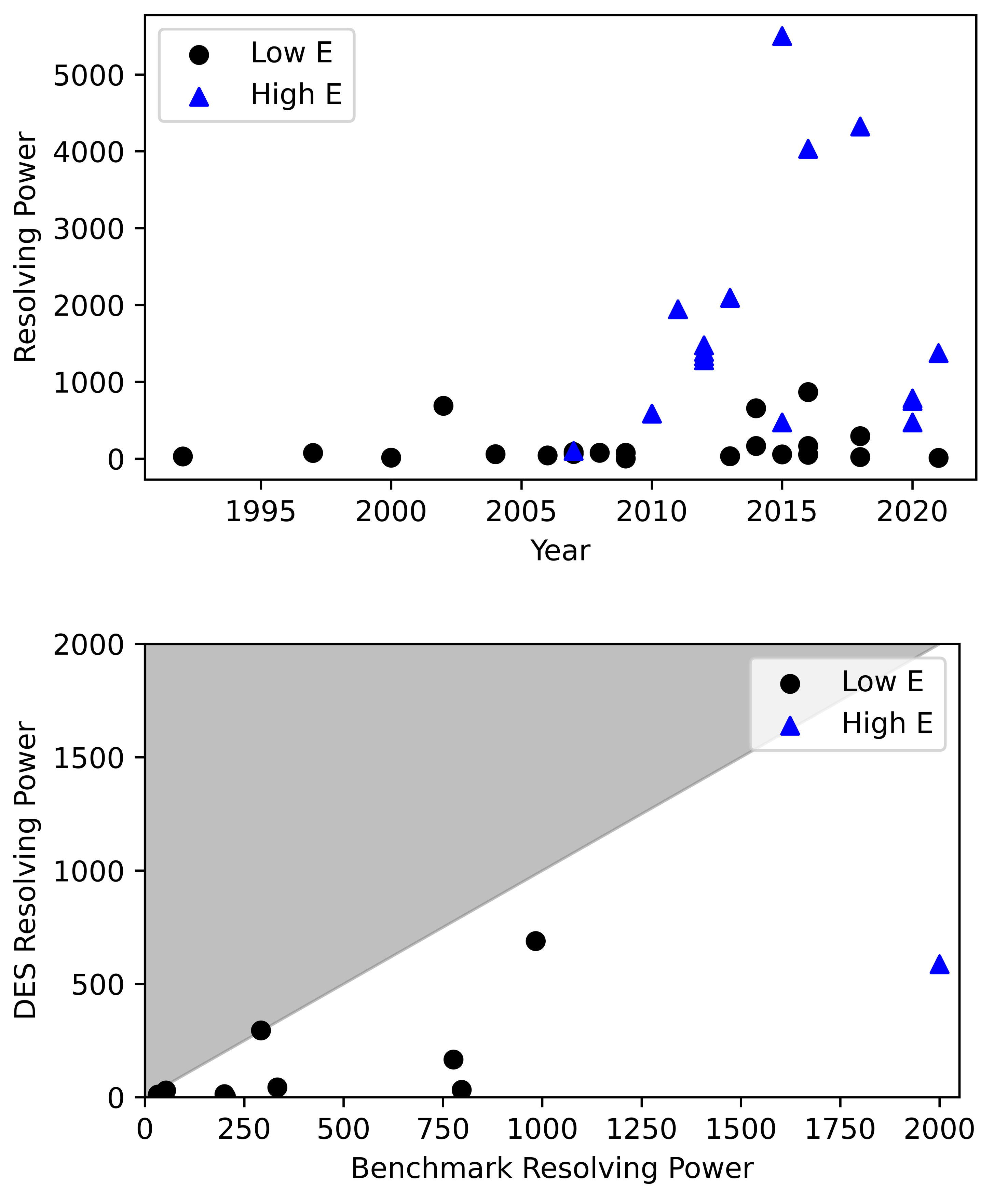
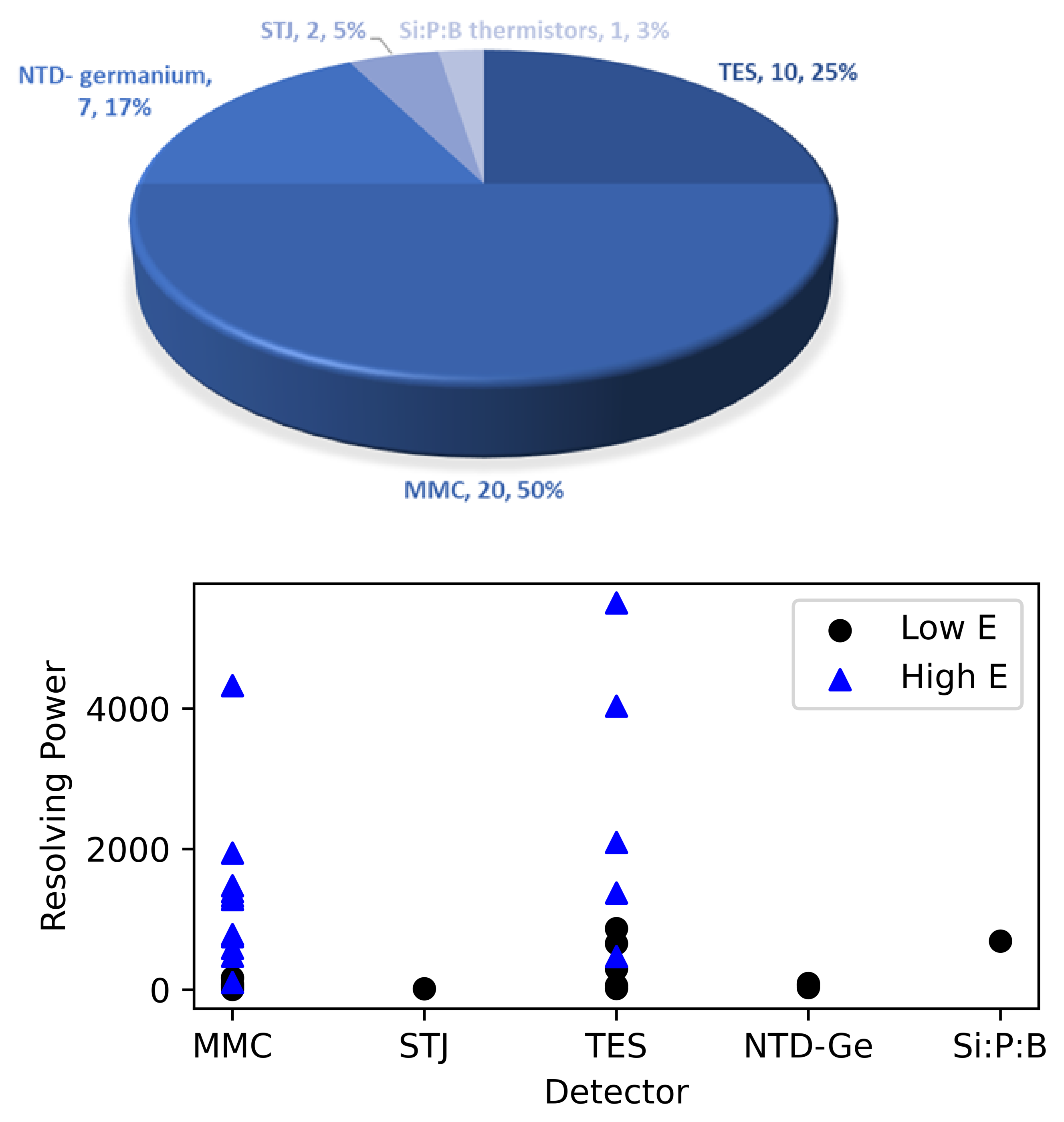
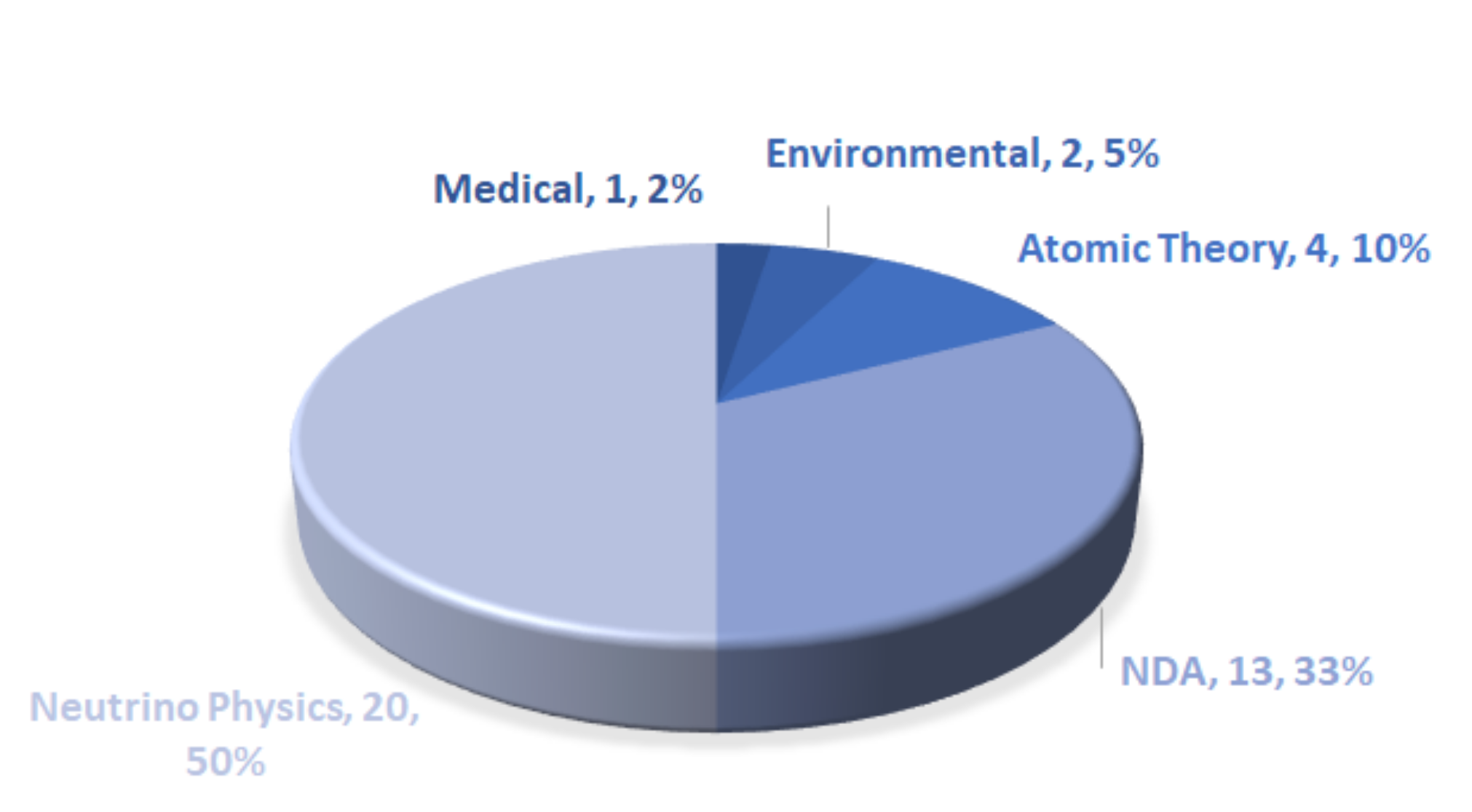
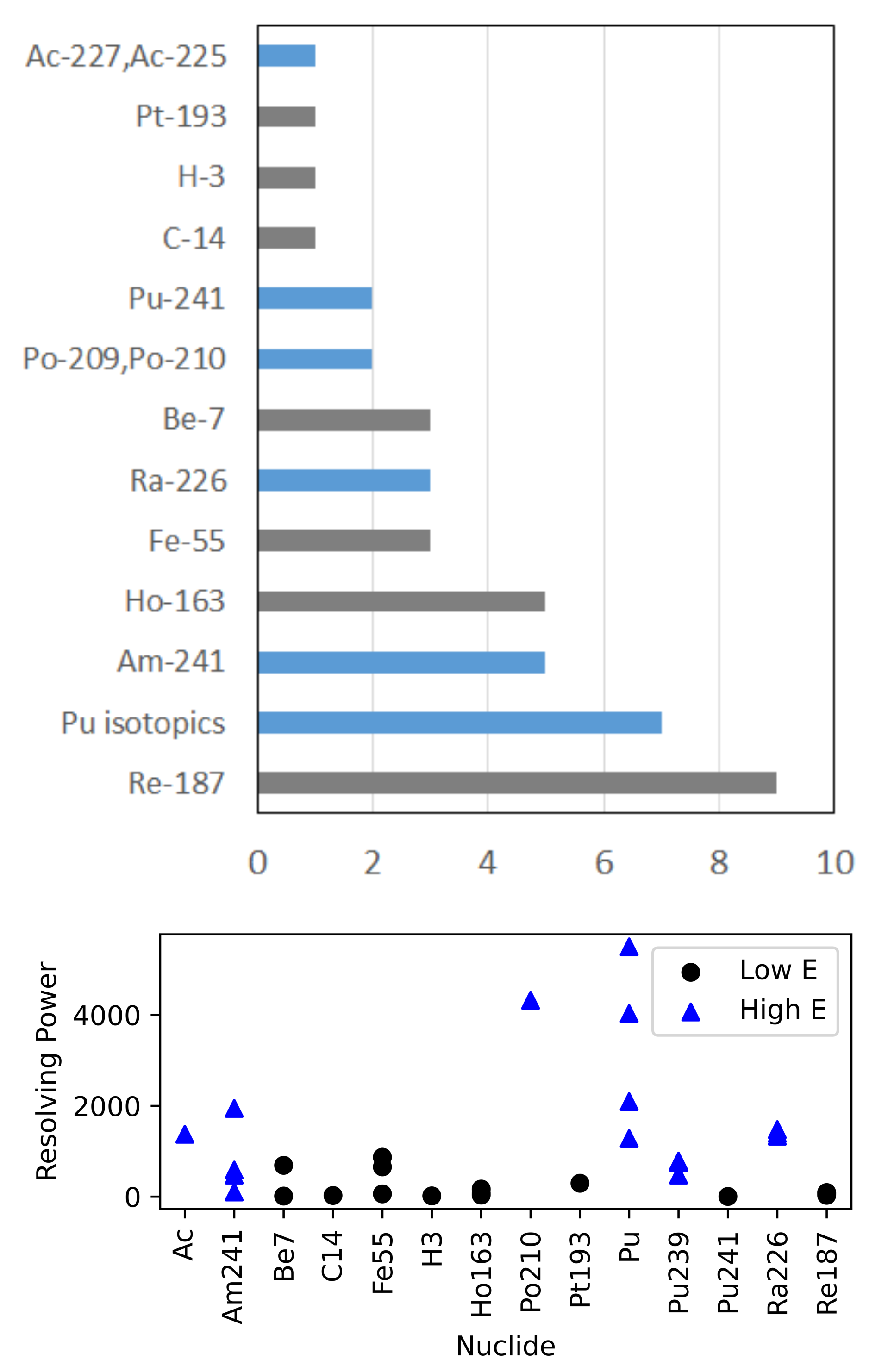
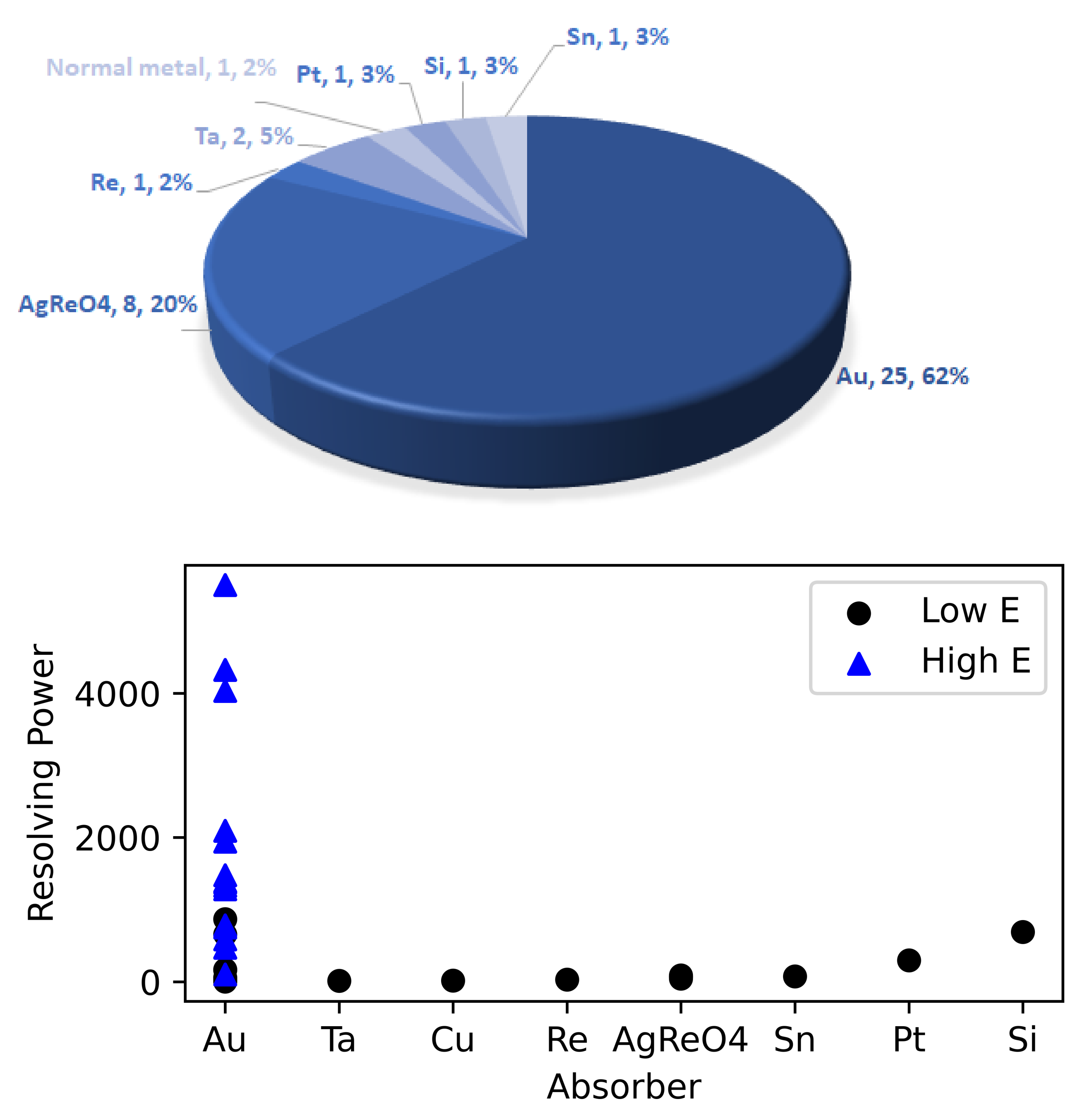
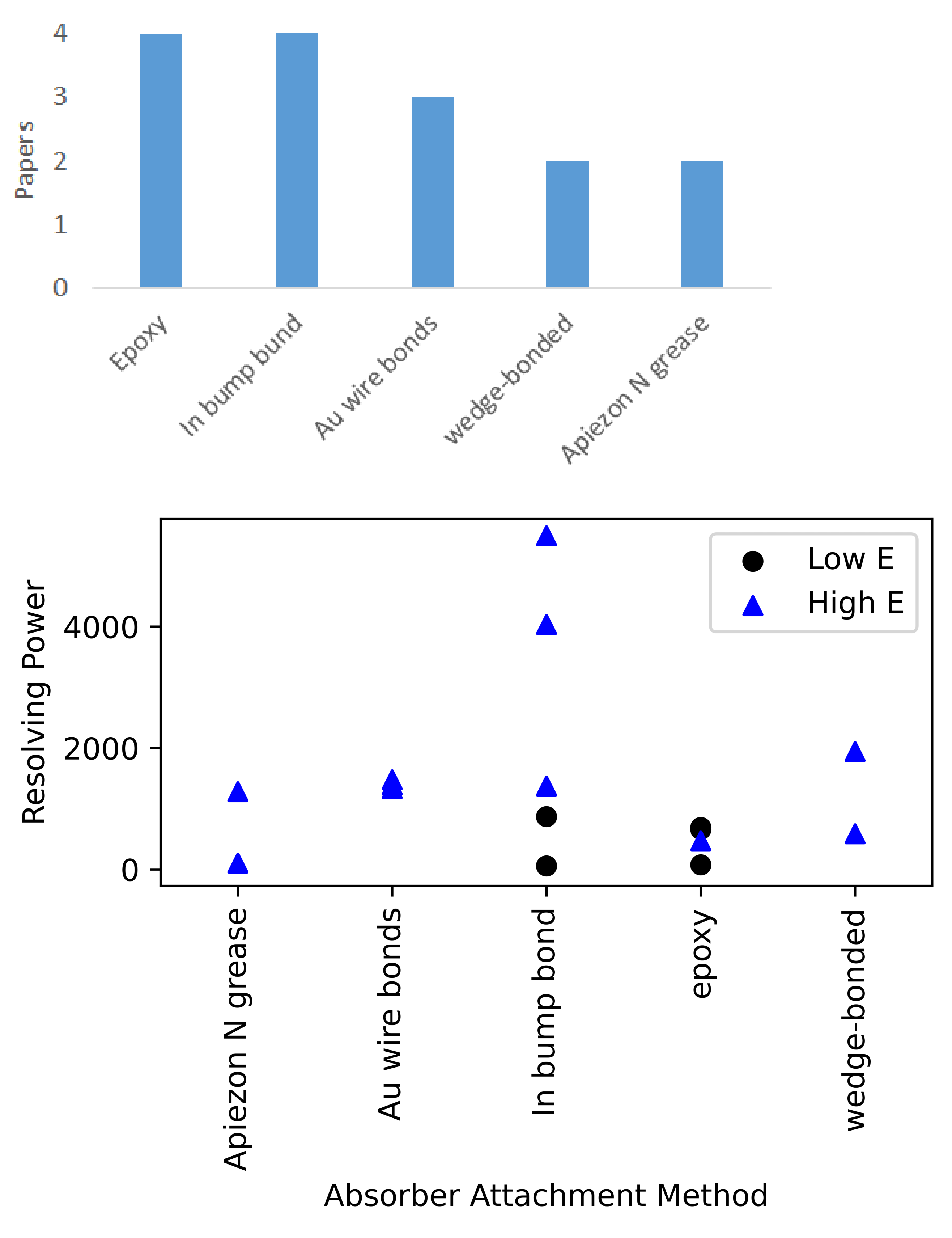
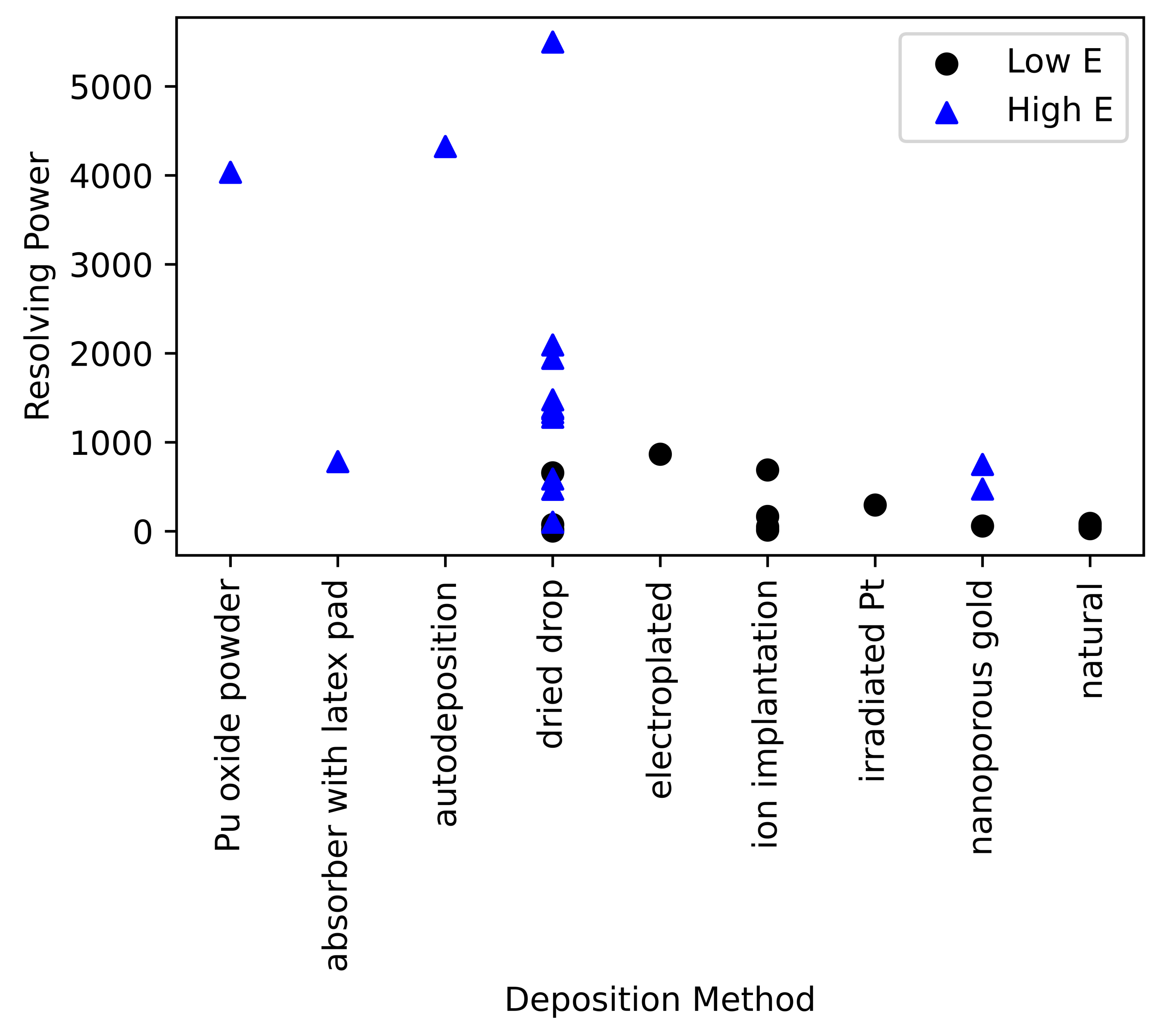

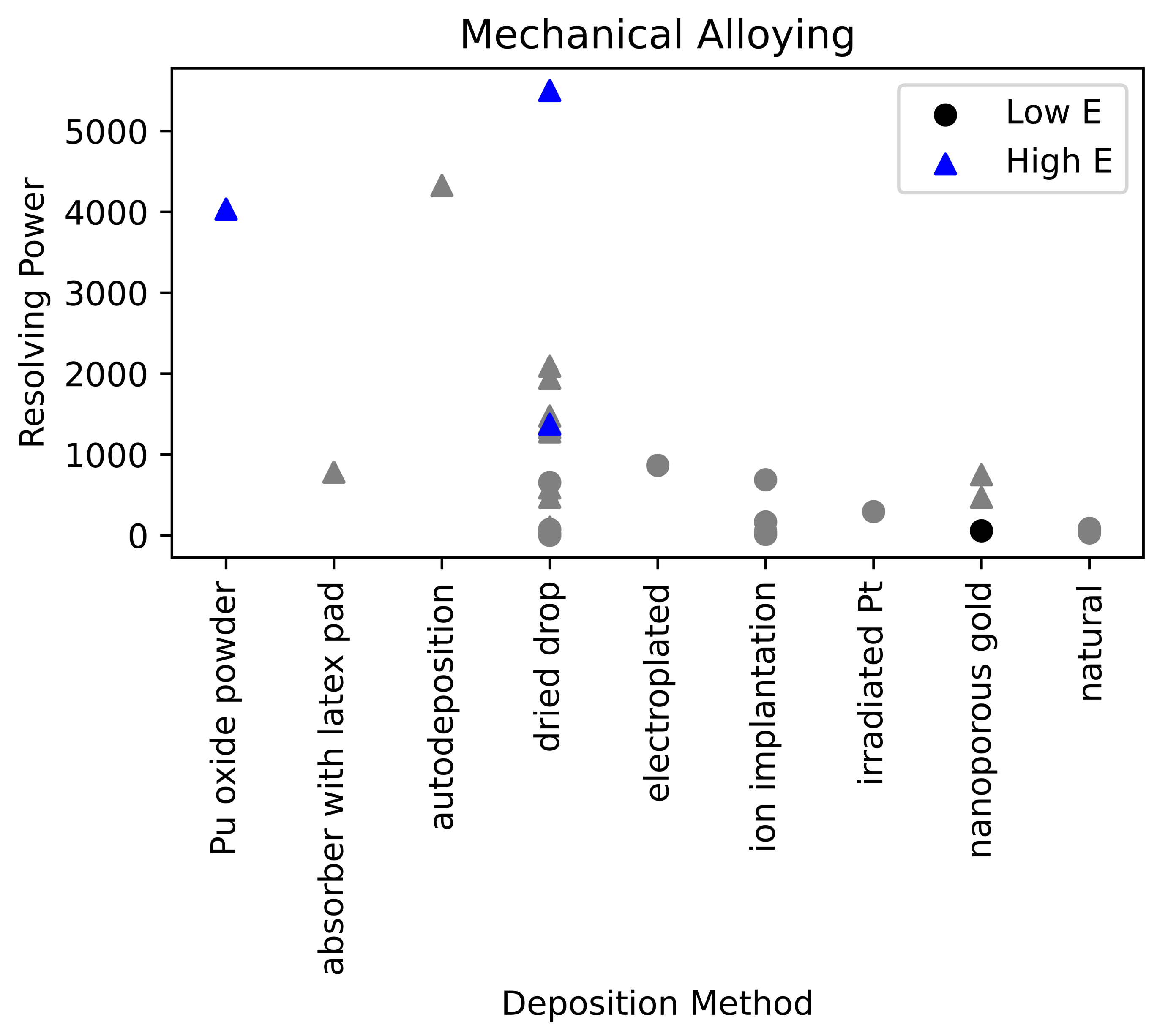
| Ref. | First Author | Year | Application | Detector | Absorber Material | Nuclide | Deposition | Attachment |
|---|---|---|---|---|---|---|---|---|
| [15] | Cosulich | 1992 | Neutrino mass | NTD-Ge | Re | Re | natural | |
| [16] | Gatti | 1997 | Neutrino mass | NTD-Ge | Sn | Ho | dried drop | epoxy |
| [14] | Deptuck | 2000 | Neutrino mass | TES | Cu | H | ion implantation | |
| [17] | Voytas | 2002 | Atomic Theory | Si:P:B | Si | Be | ion implantation | epoxy |
| Ref. | Radiation Source | FWHM | E | Power | Comparison Source | FWHM | E | Power |
|---|---|---|---|---|---|---|---|---|
| [15] | Beta | 0.05 | 1.5 | 30 | X-ray | 0.565 | 30 | 53 |
| [16] | Beta | 0.08 | 6 | 75 | ||||
| [14] | EC | 0.0085 | 0.12 | 14 | tests | 0.03 | 6 | 200 |
| [17] | Beta | 0.09 | 62 | 689 | X-ray | 0.006 | 5.9 | 983 |
Publisher’s Note: MDPI stays neutral with regard to jurisdictional claims in published maps and institutional affiliations. |
© 2021 by the author. Licensee MDPI, Basel, Switzerland. This article is an open access article distributed under the terms and conditions of the Creative Commons Attribution (CC BY) license (https://creativecommons.org/licenses/by/4.0/).
Share and Cite
Koehler, K.E. Low Temperature Microcalorimeters for Decay Energy Spectroscopy. Appl. Sci. 2021, 11, 4044. https://doi.org/10.3390/app11094044
Koehler KE. Low Temperature Microcalorimeters for Decay Energy Spectroscopy. Applied Sciences. 2021; 11(9):4044. https://doi.org/10.3390/app11094044
Chicago/Turabian StyleKoehler, Katrina E. 2021. "Low Temperature Microcalorimeters for Decay Energy Spectroscopy" Applied Sciences 11, no. 9: 4044. https://doi.org/10.3390/app11094044
APA StyleKoehler, K. E. (2021). Low Temperature Microcalorimeters for Decay Energy Spectroscopy. Applied Sciences, 11(9), 4044. https://doi.org/10.3390/app11094044






